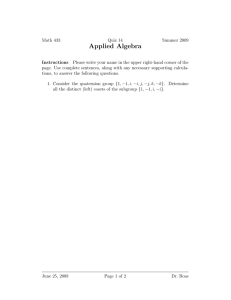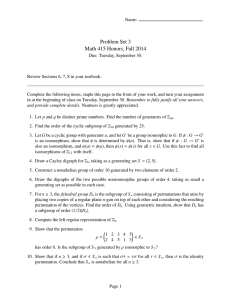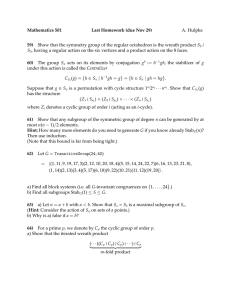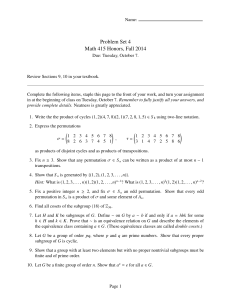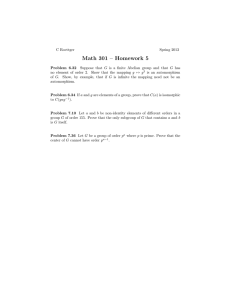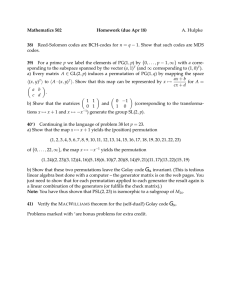CONSTRUCTION OF Co . AN EXAMPLE OF THE USE COMPUTATIONAL GROUP THEORY
advertisement
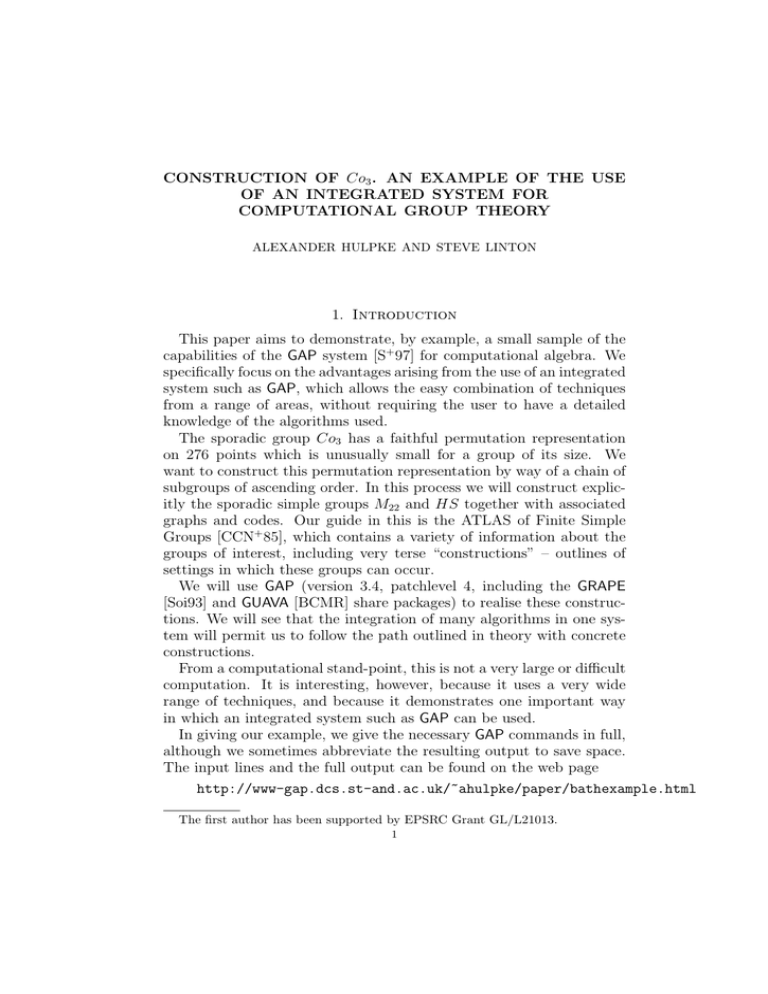
CONSTRUCTION OF Co3 . AN EXAMPLE OF THE USE
OF AN INTEGRATED SYSTEM FOR
COMPUTATIONAL GROUP THEORY
ALEXANDER HULPKE AND STEVE LINTON
1. Introduction
This paper aims to demonstrate, by example, a small sample of the
capabilities of the GAP system [S+ 97] for computational algebra. We
specifically focus on the advantages arising from the use of an integrated
system such as GAP, which allows the easy combination of techniques
from a range of areas, without requiring the user to have a detailed
knowledge of the algorithms used.
The sporadic group Co3 has a faithful permutation representation
on 276 points which is unusually small for a group of its size. We
want to construct this permutation representation by way of a chain of
subgroups of ascending order. In this process we will construct explicitly the sporadic simple groups M22 and HS together with associated
graphs and codes. Our guide in this is the ATLAS of Finite Simple
Groups [CCN+ 85], which contains a variety of information about the
groups of interest, including very terse “constructions” – outlines of
settings in which these groups can occur.
We will use GAP (version 3.4, patchlevel 4, including the GRAPE
[Soi93] and GUAVA [BCMR] share packages) to realise these constructions. We will see that the integration of many algorithms in one system will permit us to follow the path outlined in theory with concrete
constructions.
From a computational stand-point, this is not a very large or difficult
computation. It is interesting, however, because it uses a very wide
range of techniques, and because it demonstrates one important way
in which an integrated system such as GAP can be used.
In giving our example, we give the necessary GAP commands in full,
although we sometimes abbreviate the resulting output to save space.
The input lines and the full output can be found on the web page
http://www-gap.dcs.st-and.ac.uk/~ahulpke/paper/bathexample.html
The first author has been supported by EPSRC Grant GL/L21013.
1
2
ALEXANDER HULPKE AND STEVE LINTON
The complete example session took about 16 minutes on the authors’
200MHz PentiumPro PC running Linux and used about 10MB of GAP
workspace.
Some of the calculations rely on random selections. This can make
it difficult to reproduce the results. The GAP session presented here
results from starting GAP 3.4.4 (which initializes the random number generator to a defined state) and calling exactly the commands
listed. If the reader repeats this, she should end up with the same objects. In other circumstances or other versions, input (such as explicit
points) that is taken from former output has to be modified accordingly.
Though the output of some functions that rely on random methods is
abbreviated here (but can be seen in full on the mentioned web page)
output relevant for later input is always given.
2. The Construction of M22 .2
We begin with polynomials. By defining an indeterminate, we obtain F2 [x]. We assign a name to this indeterminate so that it will be
displayed in a nice way.
gap> x:=Indeterminate(GF(2));
X(GF(2))
gap> x.name:="x";;
Now we work with polynomials. We define a small degree polynomial
(this is where the number 23 comes in) and factor it. Over Z it would
split just into two factors, but over F2 we get further factors. We take
one of them.
gap> f:=x^23-1;
Z(2)^0*(x^23 + 1)
gap> Factors(f);
[ Z(2)^0*(x + 1), Z(2)^0*(x^11 + x^10 + x^6 + x^5 + x^
4 + x^2 + 1), Z(2)^0*(x^11 + x^9 + x^7 + x^6 + x^
5 + x + 1) ]
gap> f:=First(Factors(f),i->Degree(i)>1);
Z(2)^0*(x^11 + x^10 + x^6 + x^5 + x^4 + x^2 + 1)
We next define a code from this polynomial. For this we use the
share package GUAVA [BCMR].
gap> RequirePackage("guava");
GUAVA, Version 1.3
Jasper Cramwinckel, Erik Roijackers, Reinald Baart, Eric Minkes
gap> cod:=GeneratorPolCode(f,23,GF(2));
a cyclic [23,12,1..7]3 code defined by generator polynomial over GF(2)
This code is the binary Golay code, we check a well-known property.
AN EXAMPLE OF THE USE OF AN INTEGRATED CGT SYSTEM
3
gap> IsPerfectCode(cod);
true
If we extend the code by a parity bit, we get the extended Golay code.
This code has automorphism group M24 . The weight distribution for
this extended code, that GUAVA can compute for us, gives the well
known numbers of subsets in the corresponding Steiner system.
gap> ext:=ExtendedCode(cod);
a linear [24,12,8]4 extended code
gap> WeightDistribution(ext);
[ 1, 0, 0, 0, 0, 0, 0, 0, 759, 0, 0, 0, 2576, 0, 0, 0,
759, 0, 0, 0, 0, 0, 0, 0, 1 ]
GUAVA uses an external program desauto [Leo91] to compute the automorphism group of this code. We check that the size of the obtained
group is indeed the size of M24 and that it acts quintuply transitive.
gap> m24:=AutomorphismGroup(ext); m24.name:="m24";
Group( ( 1, 2)( 6,15,24,18)( 7,14,12,19)( 9,17,16,20)
[...]
gap> Size(m24);
244823040
gap> Transitivity(m24,[1..24]);
5
M22 .2 is the stabilizer of a duad (a set of size 2) in M24 . As M24 acts
quintuply transitive it is unimportant which points we select. (The
simple group M22 itself could be obtained by computing the pointwise
stabilizer, using the GAP operation OnTuples instead.) The action of
M22 .2 on the remaining points is faithful.
gap> m22a:=Stabilizer(m24,[23,24],OnSets);
Subgroup( m24, [ ( 1, 3)( 5,17)( 6,18)( 7,10)( 8,16)
[...]
gap> Size(m22a);
887040
gap> m22a:=Operation(m22a,[1..22]);m22a.name:="m22a";;
Group( ( 1, 3)( 5,17)( 6,18)( 7,10)( 8,16)( 9,13)(11,20)
[...]
gap> Size(m22a);
887040
3. The Construction of HS
Now we need a little bit of theory. The ATLAS [CCN+ 85] tells us on
page 80:
4
ALEXANDER HULPKE AND STEVE LINTON
Graph
G.2: the automorphism group of the graph of D.G.Higman
and C.C. Sims, a rank 3 graph of valence 22 on 100 vertices.
Any given vertex has 22 neighbours (points),
and each of the remaining 77 vertices is joined to 6 of these points
and may be labelled by the corresponding hexad.
Two of these 77 vertices are joined just
if the corresponding hexads are disjoint.
1
2
3
4
5
and on the bottom of the page:
Order
443520
Index Structure G.2
100 M22
: M22:2
Character
1a+22a+77a
Graph
point
We deduce that (1) HS.2 acts on a graph Γ (the Higman-Sims graph)
with 100 vertices (2). There only is one permutation representation
of degree 100 for HS.2 (6), the point stabilizer is of type M22 .2. The
graph has rank 3 (2), that is the point stabilizer has 3 orbits on the
100 points. A vertex in Γ has 22 neighbours (2) and therefore the point
stabilizer must have an orbit of length 22. As it only has 3 orbits there
is one remaining orbit of length 100 − 1 − 22 = 77.
We will construct this graph using the point stabilizer and therefore
have to construct M22 .2 in its intransitive permutation action on 100
points with orbits of lengths 1,22 and 77.
3.1. A representation of M22 .2 on 77 points. The first step of
this construction will be to obtain the transitive action of M22 .2 on 77
points. We will get it by acting on the cosets of a suitable subgroup.
To find this subgroup we use the classification of maximal subgroups
of M22 given in the ATLAS, in which we find the line:
Order
5760
Index
77
Structure
2^4:A_6
G.2
2^4:S_6
Abstract
N(2A^4)
Mathieu
hexad
This tells us:
• M22 has a permutation representation of degree 77 which extends
to M22 .2.
• The point stabilizer in this action is a subgroup H < M22 .2 of
type 24 : S6 . This subgroup has a normal subgroup E of type 24 ,
of which it must be the normalizer in M22 .2.
• As it has odd index 77, H must contain a full Sylow 2 subgroup
of M22 .2. Therefore E, which certainly is contained in a Sylow
subgroup, must be normal also in the Sylow 2 subgroup.
• As stabilizer of a hexad, H (and therefore E as well) stabilizes a
set of 6 points in the permutation representation on 22 points.
6
AN EXAMPLE OF THE USE OF AN INTEGRATED CGT SYSTEM
5
To get H we will look for normal subgroups of order 24 in a Sylow
2 subgroup. As a Sylow subgroup is polycyclic, we convert it to an
AgGroup. This is a special representation for solvable groups in which
the computations we want to do run more quickly.
gap> s:=SylowSubgroup(m22a,2);;
gap> a:=AgGroup(s);
Group( g1, g2, g3, g4, g5, g6, g7, g8 )
We compute all elementary abelian normal subgroups of size 16 in
this group, there are 5 of them.
gap> n:=Filtered(NormalSubgroups(a),i->Size(i)=16
>
and IsElementaryAbelian(i));
[ Subgroup( Group( g1, g2, g3, g4, g5, g6, g7, g8 ),
[ g1, g3, g6*g7, g8 ] ), [...]
The component bijection of the group a is an homomorphism back
into the permutation group. We use it to get these subgroups as permutation groups.
gap> n:=List(n,i->Image(a.bijection,i));;
To pick the right E, we could now look at the sizes of the normalizers
of the subgroups in n and it would turn out that only one of them has
the right normalizer size. We happen to know, however, that E acts
regularly. (The remaining 6 points form the hexad stabilized by the
normalizer.) There only is one group satisfying these conditions. We
take this group and compute its normalizer.
gap>
gap>
1
gap>
gap>
e:=Filtered(n,i->IsRegular(i,PermGroupOps.MovedPoints(i)));;
Length(e);
e:=e[1];;
h:=Normalizer(m22a,e);;
Now we compute the action on the cosets.
gap> mop:=Operation(m22a,RightCosets(m22a,h),OnRight);;
gap> DegreeOperation(mop,[1..100]);
77
It is worth mentioning, that the following command
mop:=Operation(m22a,CanonicalRightTransversal(m22a,h),
OnCanonicalCosetElements(m22a,h));;
produces essentially the same result, but usually works much more
quickly and uses less space.
The corresponding operation homomorphism is the link between the
two permutation representations.
gap> ophom:=OperationHomomorphism(m22a,mop);;
6
ALEXANDER HULPKE AND STEVE LINTON
3.2. Representing M22 .2 on 100 points. To obtain the action on
100 points we form the direct product of two copies of M22 .2 acting on
22 and on 77 points respectively and take its diagonal subgroup. We
can simply regard 100 as the fixed point.
We get the diagonal subgroup by taking the product of the images
of each generator under both embeddings.
gap>
gap>
gap>
gap>
>
dp:=DirectProduct(m22a,mop);;
emb1:=Embedding(m22a,dp,1);;
emb2:=Embedding(mop,dp,2);;
diag:=List(m22a.generators,
i->Image(emb1,i)*Image(emb2,Image(ophom,i)));;
We create the group generated by these diagonal elements and give
it a name. (Note that GAP requires us to give the identity here, as
diag is a list which could be empty.)
gap> diag:=Group(diag,());;
gap> diag.name:="M22.2-99";
3.3. The Higman-Sims Graph. It is now time to construct the
graph. For this we use the share package GRAPE.
gap> RequirePackage("grape");
Loading GRAPE 2.31 (GRaph Algorithms using PErmutation groups),
by L.H.Soicher@qmw.ac.uk.
GRAPE works with graphs, making maximum use of known automorphisms. We start with an empty graph on 100 vertices on which
M22 .2 acts and adjoin orbits of edges.
gap> gamma:=NullGraph(diag,100);
rec( isGraph := true,
group := M22.2-99,
representatives := [ 1, 23, 100 ],
[...]
Graphs in GRAPE are directed, so we have to add each edge in two
directions. The first edge is to connect the point 100 to the orbit of
size 22 to make up for valence 22 (2):
gap> AddEdgeOrbit(gamma,[1,100]);AddEdgeOrbit(gamma,[100,1]);
Now we connect vertices in the orbit of length 77 with vertices in the
orbit of length 22, using line (4) of the description from the ATLAS.
The construction of direct products for permutation groups in GAP
maps the first factor on the same permutations and the second factor
on permutations shifted by the degree of the first factor. Therefore we
can use the representative 23 for the orbit of length 77 and know that
this point is the point stabilized by the subgroup H ≤ M22 .2. The
corresponding hexad (in the first 22 points) must be stabilized by H.
AN EXAMPLE OF THE USE OF AN INTEGRATED CGT SYSTEM
7
We have already observed that H has only one orbit of length 6 in its
action on 22 points. We fetch this orbit to obtain the hexad and add
the corresponding edges. As the computation of the Sylow subgroup
used random methods the reader may get a different hexad as a result.
See the comment on random methods at the end of the first section.
gap> hexad:=First(Orbits(h,[1..22]),i->Length(i)=6);
[ 2, 8, 17, 15, 22, 6 ]
gap> for i in hexad do AddEdgeOrbit(gamma,[i,23]);
> AddEdgeOrbit(gamma,[23,i]); od;
Looking at the neighbourhood of 23 we see that we have not yet
reached valence 22.
gap> Adjacency(gamma,23);
[ 2, 6, 8, 15, 17, 22 ]
Indeed, we still have to consider the next rule (5), to determine edges
within the orbit of size 77. Because we have a group acting, it is
sufficient to test for each representative of the orbits of the stabilizer
of 23, whether it is joined to 23. The other edges in the orbits will be
added automatically by GRAPE.
gap> stab:=Stabilizer(diag,23);;
gap> orbs:=Orbits(stab,[24..99]);;
gap> orbreps:=List(orbs,i->i[1]);
[ 24, 39 ]
The hexad corresponding to a point a in the 77-point orbit consists
(we constructed the graph that way) of the points in the first orbit
adjacent to a. The hexad corresponding to 23 is already known as
hexad.
gap> Intersection(hexad,Adjacency(gamma,24));
[ 15, 17 ]
gap> Intersection(hexad,Adjacency(gamma,39));
[ ]
This tells us that 23 must be joined only to 39. We add this edge
orbit.
gap> AddEdgeOrbit(gamma,[23,39]); AddEdgeOrbit(gamma,[39,23]);
Now we have completed the graph we want. We check that it is
indeed a simple graph, look at the adjacency of 23 and find out that it
is distance regular.
gap> IsSimpleGraph(gamma);
true
gap> Adjacency(gamma,23);
[ 2, 6, 8, 15, 17, 22, 39, 42, 46, 49, 52, 56, 63, 68, 70, 76, 80,
81, 86, 90, 93, 94 ]
8
ALEXANDER HULPKE AND STEVE LINTON
gap> IsDistanceRegular(gamma);
true
Finally, we compute the automorphism group of gamma. Once again
an external program (nauty, [McK90]) is used, but we do not see it:
gap> aug:=AutGroupGraph(gamma);;
gap> Size(aug);
88704000
Indeed the size is correct for HS.2. We can confirm this by looking
at the composition series. GAP identifies simple composition factors by
their size and the degree of a primitive permutation action, using the
classification of finite simple groups.
gap> DisplayCompositionSeries(aug);
(G) (3 gens, size 88704000)
| Z(2)
(S) (2 gens, size 44352000)
| HS
(1) (0 gens)
We get HS as the derived subgroup of HS.2.
gap> hs:=DerivedSubgroup(aug);;
4. Getting Co3
Now we want to construct Co3 . The ATLAS tells us (page 134)
that Co3 has a permutation representation on 276 points in which the
point stabilizer is M cL:2. Furthermore HS is a maximal subgroup of
Co3 . If we can construct HS in this permutation representation on 276
points, then, together with one further suitably constructed element it
will generate Co3 . The construction is not mentioned explicitly in the
ATLAS but this “amalgamation” of subgroups is a standard technique
for the construction of sporadic groups [PW90].
The picture will illustrate the construction
process. The first step will be to construct HS as a permutation group acting on 276 points. The smallest degrees
of faithful permutation representations of
HS are 100, 176 and 1100. Therefore, as
a subgroup of Co3 , HS has two orbits of
lengths 100 and 176 respectively.
(HS cannot have any fixed points because it is not contained in M cL:2.)
The stabilizer in HS of a point in an orbit of length 176 is of type
U3 (5):2, but there is no description of how to find such a subgroup
U ≤ HS of index 176 when only the representation of HS on 100
@Co3
@
HS100@ M cL:2
HS
@
@ 276
@
@
@ L3 (4).22
@
M22@
U3 (5):2
@
@ L3 (4)
AN EXAMPLE OF THE USE OF AN INTEGRATED CGT SYSTEM
9
points is known. Instead we will try to find elements by random search
in the permutation representation of HS on 100 points that generate
such a subgroup U . As the index [HS : U ] is relatively small we have
good chances. We just have to decide which of the element orders
occurring in U3 (5):2 to try to find a suitable U .
To determine our chances of success we use the character tables of
U3 (5), U3 (5):2 and HS. We can look them up in the ATLAS but they
are more conveniently obtained from a GAP data base.
gap> ct:=CharTable("U3(5)");;ct2:=CharTable("U3(5).2");;
gap> cths:=CharTable("hs");;
gap> ct.orders;ct2.orders;cths.orders;
[ 1, 2, 3, 4, 5, 5, 5, 5, 6, 7, 7, 8, 8, 10 ]
[ 1, 2, 3, 4, 5, 5, 5, 6, 7, 8, 10, 2, 4, 6, 8, 10, 12, 20, 20 ]
[ 1, 2, 2, 3, 4, 4, 4, 5, 5, 5, 6, 6, 7, 8, 8, 8, 10, 10,
11, 11, 12, 15, 20, 20 ]
The character tables show that U3 (5):2 contains elements of order 12
which U3 (5) does not. Thus an element of order 12 will ensure that
we find U and not its derived subgroup U 0 . Furthermore HS contains
only one class of elements of order 12 and this class is self-centralizing.
Therefore there is a chance of 1/12 that a random element of HS has
order 12 and we know that there is a conjugate of U3 (5):2 in HS that
contains this element. We search for such an element of order 12 which
we denote by e1 and compute its 6th power e2.
gap> repeat e1:=Random(hs);until OrderPerm(e1)=12;
gap> e2:=e1^6;;
As 6 is divisible by 2, e2 must lie in U3 (5) and is therefore in the first
class of elements of order 2. This class in U3 (5):2 has 525 elements
gap> ct2.classes[2];
525
Along the lines of [Lin95] we can now estimate how much random
search is required to find a subgroup of HS isomorphic to U3 (5) : 2. In
HS, the 6th power of an element of order 12 lies in the second class.
(GAP stores only prime power maps from which all power maps can
be deduced. Therefore we compute the sixth power as the cube of the
square.) We can read from the table that the class of e2 in HS is of
order 5775.
gap> cths.orders[21];
12
gap> cths.powermap[3][cths.powermap[2][21]];
2
gap> cths.classes[2];
5775
10
ALEXANDER HULPKE AND STEVE LINTON
If we take random conjugates of e2 about every 10th conjugate will lie
in a maximal subgroup of type U3 (5):2 which contains also e1.
A similar count of pairs for the maximal subgroups of U3 (5):2 (which
is left to the reader) establishes that at least every second conjugate
of e2 in U3 (5):2 together with e1 generates the full group U3 (5):2.
Therefore we can assume that in the mean at least one of 20 conjugates
of e2 in HS together with e1 will generate a maximal subgroup U
isomorphic to U3 (5):2 and we can find it by a random search. (As
U operates transitively on 100 points the until statement has to use
the index and cannot check for orbit lengths which otherwise would be
quicker.)
gap> cnt:=0;;repeat u:=Subgroup(aug,[e1,e2^Random(hs)]);
> cnt:=cnt+1;until Index(hs,u)=176;cnt;
26
We were a little bit unlucky in that we had to try 26 random subgroups.
(Anyhow this random search took only about 7 seconds on the authors’
system.)
We now construct the operation of HS on the cosets of U . Again
we use the special operation on canonical coset representatives (which
saves over 40MB of memory and several minutes of runtime). We
test that its image is indeed primitive. (So U is indeed a maximal
subgroup and we don’t have to rely on the list of maximal subgroups
being complete.) Afterwards we construct a diagonal action of HS on
100+176 points by mirroring the process used above for M22 .2.
gap> hsop:=Operation(hs,CanonicalRightTransversal(hs,u),
> OnCanonicalCosetElements(hs,u));;
gap> IsPrimitive(hsop,[1..176]);
true
gap> ophom:=OperationHomomorphism(hs,hsop);;
gap> dp:=DirectProduct(hs,hsop);;
gap> emb1:=Embedding(hs,dp,1);;
gap> emb2:=Embedding(hsop,dp,2);;
gap> diag:=List(hs.generators,
>
i->Image(emb1,i)*Image(emb2,Image(ophom,i)));;
gap> diag:=Group(diag,());;diag.name:="hs-276";;
4.1. Search for a further element. The strategy for finding a further element is as follows: Such elements exist in M cL:2. At this
point, however, we don’t have M cL:2 in an appropriate action. We
may choose conjugates such that HS ∩ M cL:2 = M22 (M cL:2 is a stabilizer of a point in the action of Co3 on 276 points and M22 is a point
stabilizer in the orbit of length 100 of HS).
AN EXAMPLE OF THE USE OF AN INTEGRATED CGT SYSTEM
11
Assume that T is a subgroup of HS such that NM cL:2 (T ) 6≤ HS. In
this case there are elements in NM cL:2 (T ) which are not in HS and we
can take such an element as a further generator for Co3 . We will see
that (with appropriate choice of T ) such elements can be found directly
from the automorphism action they induce on T . We shall obtain this
action from the automorphism group of T .
A look at the ATLAS list of maximal subgroups of M cL:2 shows
that the outer automorphism of M22 cannot be realized in M cL:2 and
therefore we cannot simply choose T = M22 . If we look at the point
stabilizer in the action of M22 on 22 points, we have more luck: This
group is of type L3 (4) and while HS contains a maximal subgroup of
type L3 (4).21 , M cL:2 contains L3 (4).22 . So we can choose T to be this
subgroup L3 (4).21 .
Furthermore, T is just the stabilizer in HS of an edge of the HigmanSims graph and is therefore easily obtainable. Again we use that the
direct product construction mapped the copy of HS acting on 100
points to the same permutations, so we can simply use the graph we
have constructed already and do not need to do any point translation.
gap> adj:=Adjacency(gamma,1);
[ 79, 80, 81, 82, 83, 84, 85, 86, 87, 88, 89, 90, 91,
92, 93, 94, 95, 96, 97, 98, 99, 100 ]
gap> t:=Stabilizer(diag,[1,adj[1]],OnSets);;
Because we computed T as stabilizer it might have many generators.
For the computation of the automorphism group of T , however, it will
be helpful to have a subgroup with fewer generators. Therefore we look
at subgroups generated by two random elements of T and find quickly
two elements which generate a subgroup that equals T and use this
generated subgroup as T further on.
gap> cnt:=0;;repeat s:=Subgroup(diag,[Random(t),Random(t)]);
> cnt:=cnt+1;until Size(s)=Size(t);cnt;t:=s;
1
We know (well, have strong indications. For a proof we would have
to classify subgroups of M cL isomorphic to L3 (4)) that there is an
element g ∈ M cL:2 which normalizes T and is not contained in HS.
We want to obtain this element from its automorphism action on T .
4.2. Finding suitable automorphisms. Now we start by computing
the automorphism group of T . (In principle it should be possible to use
the command AutomorphismGroup here. There is, however, a problem
with GUAVA that we used before: it overwrites the dispatcher function
for AutomorphismGroup).
gap> aus:=t.operations.AutomorphismGroup(t);;
12
ALEXANDER HULPKE AND STEVE LINTON
gap> Size(aus);
241920
As we want an outer automorphism, we take the subgroup of inner automorphisms of T (GAP has already computed a generating set
and stored it) and consider a transversal in the outer automorphism
group. As we are looking for an automorphism of order two, we select
those representatives from this transversal whose order modulo the inner automorphisms is 2. (It might be worth mentioning that these
few calculations in the automorphism group, together with the calculation of the automorphism group itself, actually take up more than 65
percent of the total runtime!)
gap>
gap>
6
gap>
gap>
gap>
3
gap>
[ 2,
inner:=Subgroup(aus,aus.innerAutomorphisms);;
Index(aus,inner);
rt:=RightTransversal(aus,inner);;
automs:=Filtered(rt,i->i^2 in inner and not i in inner);;
Length(automs);
List(automs,i->Order(aus,i));
2, 2 ]
We were lucky in that all the coset representatives we got have order
2 (and that is a proof that every coset contains a representative of
order 2. The reader starting with different initial data may end up
with representatives of composite order. If this is the case, she can
multiply these with inner automorphisms to obtain representatives of
order 2 for the same cosets. This may require some random searching).
There are three possible representatives. We will continue with all
three of them for now. It will turn out later that only one of them is a
suitable candidate.
If we look at the orbits of T
gap> ot:=Orbits(t,[1..276]);;
gap> List(ot,Length);
[ 2, 56, 42, 56, 120 ]
we see that the only orbits of T that its normalizer in Co3 may swap are
those of length 56, the other orbits must remain fixed. (On the other
hand, as this normalizer together with HS generates Co3 it then must
swap these to obtain a transitive action.) For each orbit of length 6= 56
and for the fused orbit of length 112 we then construct a permutation
in the symmetric group on this orbit which by conjugation induces the
same action on the image of T projected on this orbit as the automorphism does. Except for the orbit of length 2 this permutation on each
AN EXAMPLE OF THE USE OF AN INTEGRATED CGT SYSTEM
13
(fused) orbit is unique, as the image of the action of T on the orbit has
trivial centralizer in the full symmetric group.
4.3. Constructing a permutation. We shall need a small GAP function to compute such a permutation. For this we use a theorem (see for
example [DM96, Theorem 4.2B]) which states that an automorphism
of a permutation group is induced by conjugation with a permutation
in the symmetric group if and only if it maps a point stabilizer to another point stabilizer. In this case, the automorphism maps cosets of
the one stabilizer to cosets of the other. This can be used to define a
permutation, which then induces this automorphism.
The GAP function MappingPermListList creates a permutation which
maps one list onto another. From this we will build another function
that will try to realize automorphisms on orbits. This function gets a
permutation group grp, an automorphism aut of grp and a domain dom
on which a permutation action will be computed. If the group has two
orbits on this domain, the function will create a permutation that will
swap both orbits. If the action cannot be induced by a permutation,
false is returned.
PermutationByAutomorphism := function(grp,aut,dom)
local op,oh,p,s,sim,simp,rt,rtim,extelm,l1,l2;
# We compute the action on the given domain and transfer
# the automorphism to this permutation action
op:=Operation(grp,dom);
oh:=OperationHomomorphism(grp,op);
aut:=GroupHomomorphismByImages(op,op,op.generators,List(op.generators,
i->Image(oh,Image(aut,PreImagesRepresentative(oh,i)))));
aut.isMapping:=true; # just to save time (otherwise GAP will test that
# it is indeed a homomorphism, but we know this already)
# compute stabilizer and images
s:=Stabilizer(op,1);
sim:=Image(aut,s);
# is the image a stabilizer? It is if it has an orbit of length 1
simp:=Filtered(Orbits(sim,[1..Length(dom)]),i->Length(i)=1);
if Length(simp)=0 then
return false; # it cannot be induced by a permutation action
fi;
# the permutation can be obtained by the induced action on the right
# cosets.
simp:=simp[1][1]; #image base point
rt:=RightTransversal(op,s);
14
ALEXANDER HULPKE AND STEVE LINTON
rtim:=List(rt,i->Image(aut,i));
l1:=List(rt,i->1^i);l2:=List(rtim,i->simp^i);
# we got the images, make a permutation from them.
if Length(Orbits(grp,dom))=1 then
extelm:=MappingPermListList(l1,l2);
else
# if we have two orbits, we have to ensure they get swapped
extelm:=MappingPermListList(Concatenation(l1,l2),
Concatenation(l2,l1));
fi;
# test whether the computed element indeed fulfills the specifictions
# (This is a safety test only)
if ForAny(op.generators,i->i^extelm<>i^aut) then
Error("something went wrong");
fi;
# finally move the points acted on to the original domain.
return extelm^MappingPermListList([1..Length(dom)],dom);
end;
It turns out, that of the three candidates we had, only one is induced
by a permutation on the orbit of length 120.
gap>
gap>
>
gap>
1
gap>
lo:=First(ot,i->Length(i)=120);;
automs:=Filtered(automs,
i->PermutationByAutomorphism(t,i,lo)<>false);;
Length(automs);
autom:=automs[1];;
Now we simply build a permutation using our function. We get
unique permutations for all orbits of length 6∈ {2, 56}, and one permutation to swap the two orbits of length 56.
The product of all these is the permutation we need.
gap>
[ 2,
gap>
>
gap>
>
pos:=Filtered([1..Length(ot)],i->Length(ot[i])=56);
4 ]
perms:=List(ot{Difference([1..5],pos)},
i->PermutationByAutomorphism(t,autom,i));;
element:=Product(perms)*PermutationByAutomorphism(t,
autom,Concatenation(ot{pos}));
The permutation element is unique but for the orbit of length 2.
The element we are looking for might swap the two points in this orbit
or it might not and so we will have to try both possibilities. In this
situation, however, it turns out that swapping both points gives the
right permutation and we only show this part of the calculation, for
which we change the permutation.
AN EXAMPLE OF THE USE OF AN INTEGRATED CGT SYSTEM
gap>
[ 1,
gap>
1
gap>
15
ot[1];
79 ]
1^element;
element:=element*(1,79);;
Now we can generate Co3 . Again we check that everything went well
gap> co3:=Group(Concatenation(diag.generators,[element]),());;
gap> Size(co3);
495766656000
gap> DisplayCompositionSeries(co3);
<G> (3 gens, size 495766656000)
| Co(3)
<1> (0 gens)
Using the same techniques we could now continue and form Co1
on 98280 points by adding an outer automorphism to HS < Co3 .
The large number of points however makes this rather elaborate and
unsuitable for a presentation in this form.
5. Concluding Remarks
5.1. Summary of Example and Points to Note. We started our
calculation with a polynomial over F2 and obtained a code from its
factors. From the code we constructed M24 and hence M22 .2. In M22 .2
acting on 22 points, we found a subgroup of index 77 and so obtained
an action on 100 points. We constructed a graph on 100 vertices, on
which M22 .2 acts. The full automorphism group of this graph is HS.2.
We formed its derived subgroup HS as a subgroup of Co3 on 276 points
and, within HS, a subgroup L3 (4).2. From an automorphism of this
subgroup we obtained a permutation contained in Co3 , but not in HS.
Together with generators of HS, this permutation generates Co3 .
While these constructions were known before in theory, and had been
performed relatively explicitly by hand, most of the objects involved
are not given explicitly in a book or article. Using the very terse descriptions in the ATLAS, informed by a general knowledge of what
computations are likely to be feasible, we have turned a piece of mathematics relatively painlessly into a program. In this presentation, we
have, of course, omitted some false starts. Nevertheless, the interactive nature of GAP makes it relatively easy to develop programs of this
kind. At every stage, the full structure of all the objects is exposed, so
that we can ask GAP mathematical questions about each code, graph
or group that we construct.
As well as its considerable library of built-in algorithms, especially
for group theory, a key role of GAP in this work was to provide common
16
ALEXANDER HULPKE AND STEVE LINTON
interfaces and data structures for techniques from a number of mathematical areas, so that we could, for example, construct M24 using tools
from coding theory, manipulate it as a group and apply the results in
graph theory.
Another point to note is the pattern of working. The combination of
interactive capabilities and programmability of GAP allows a middle
road between purely interactive exploration and programming. Purely
interactive work would not (for example) have allowed us to find the
“extra” element of Co3 , because the conversion from automorphisms
to permutations was not built into GAP. On the other hand, a noninteractive “design – program – test” model would have been too cumbersome for the main thread of the construction, which is more easily
found by interactive experiment. A normal way of working with GAP
is to explore interactively, keeping a log file as a record, and stopping,
from time to time to program and debug functions that seem necessary
or useful, which thereafter act as library extensions.
5.2. Further Information. Further information about Computational
Group Theory in general can be found in excellent survey articles
[Neu95, Ser97]. The GAP system itself, and a great deal of associated information, can be found on the GAP World Wide Web site
(http://www-gap.dcs.st-and.ac.uk/~gap). In particular the site includes the GAP distribution itself, details about the authors of GAP
and of the contributed Share Packages and information about the forthcoming version 4 of the system.
The development of GAP has been supported by several grants (listed
under http://www-gap.dcs.st-and.ac.uk/~gap/Info/funding.html)
for which we are indebted to the granting bodies. We would also like
to thank the referee for many helpful comments.
References
[BCMR]
Reinalt Baart, Jasper Cramwinckel, Eric Minkes, and Erik Roijackers,
GUAVA: Users manual.
[CCN+ 85] J[ohn] H. Conway, R[obert] T. Curtis, S[imon] P. Norton, R[ichard] A.
Parker, and R[obert] A. Wilson, ATLAS of finite groups, Oxford University Press, 1985.
[DM96]
John D. Dixon and Brian Mortimer, Permutation groups, Graduate
Texts in Mathematics, vol. 163, Springer, Heidelberg, 1996.
[Leo91]
Jeffrey S. Leon, Partition backtrack programs, users manual, University
of Illinois at Chicago, Mathematics Dept., m/c 249, 1991.
[Lin95]
S[teve] A. Linton, The art and science of computing in large groups,
Proceedings of CANT ’92 (Wieb Bosma and Alf J. van der Poorten,
eds.), Kluwer, 1995, pp. 91–109.
AN EXAMPLE OF THE USE OF AN INTEGRATED CGT SYSTEM
17
[McK90]
B. D. McKay, nauty user’s guide (version 1.5), technical report tr-cs90-02, Australian National University, Computer Science Department,
ANU, 1990.
[Neu95]
Joachim Neubüser, An invitation to computational group theory, Groups
’93 Galway/St. Andrews (C. M. Campbell, T. C. Hurley, E. F. Robertson, S. J. Tobin, and J. J. Ward, eds.), London Mathematical Society Lecture Note Series, vol. 212, Cambridge University Press, 1995,
pp. 457–475.
[PW90]
R[ichard] A. Parker and R[obert] A. Wilson, The computer construction
of matrix representations of finite groups over finite fields, J. Symb.
Comput. 9 (1990), no. 5–6, 583–590.
[S+ 97]
Martin Schönert et al., GAP 3.4, patchlevel 4, Lehrstuhl D für Mathematik, Rheinisch-Westfälische Technische Hochschule, Aachen, 1997.
[Ser97]
Ákos Seress, An introduction to computational group theory, Notices
Amer. Math. Soc. 44 (1997), no. 6, 671–679.
[Soi93]
L[eonard] H. Soicher, GRAPE: a system for computing with graphs and
groups, Groups and Computation (Larry Finkelstein and William M.
Kantor, eds.), DIMACS: Series in Discrete Mathematics and Theoretical
Computer Science, vol. 21, American Mathematical Society, Providence,
RI, 1993, pp. 287–291.
E-mail address: ahulpke@dcs.st-and.ac.uk
E-mail address: sal@dcs.st-and.ac.uk
University of St. Andrews, School of Mathematical and Computational Sciences, The North Haugh, St. Andrews, Fife KY16 9SS,
United Kingdom

